He Was More Symbol Than Sweeping Leader
- Share via
BAGHDAD — His somber face, fiery invective and bloody legend helped lure foreign volunteers and cash to fuel the insurgency in Iraq. He taunted his enemies, stirred sectarian rage and took credit for some of the most shocking acts in the annals of modern terrorism.
But Abu Musab Zarqawi was mostly a looming image, a man whose contribution to the war derived largely from his symbolic value. As a military commander, he held sway over just a fraction of a fraction of the fighters who daily sow bloodshed in Iraq.
Zarqawi was at the top of the U.S. target list here, and his death seems likely to give a psychological boost to U.S. and Iraqi officials. But in a country overwhelmed by multiple competing armed groups, his end will do little to quell the violence, U.S. intelligence officials, counter-terrorism experts and independent analysts said.
“Maybe on the psychological level it will help, but realistically, on the ground, it doesn’t change a thing,” said Nawaf Obeid, a security advisor to the Saudi government who has studied the Iraq insurgency. “This pales in comparison to the real insurgency, which comes from the Iraqis themselves.”
Zarqawi, a onetime street thug who grew up in Jordan, was a phenomenon peculiar to high-tech terrorism. He made a name for himself on the Internet and satellite television with his dramatic attacks, gruesome videos and virulently anti-American and anti-Shiite Muslim rants.
His most important imprint on the war in Iraq may have been his ultra-zealous stance against the sect he recently called “Shiite snakes.”
He sought to stoke ancient animosities between the main sects of Islam, encouraging Sunni Muslims to rise up and kill Shiites. American and Iraqi officials believe he engineered the February bombing of the Shiite Golden Mosque in Samarra, an incendiary strike that unleashed waves of tit-for-tat killings.
But by now, “sectarianism has assumed a dynamic all its own, and it may be very hard to turn the page,” said Joost Hiltermann, an Iraq expert with the International Crisis Group.
Zarqawi’s death “may dampen some of the sectarian rhetoric we’ve heard,” Hiltermann said, but the feud between Iraq’s sects, which generates much of the violence in the war, is likely to continue.
Al Qaeda in Iraq, the network Zarqawi headed, was small but brutal -- a few hundred fighters by some estimates. Known as ruthless men who sawed their captives’ heads off and killed fellow Muslims, they were one of several gangs of foreigners operating in Iraq. Collectively, the interlopers are believed to account for just a small part of a predominantly homegrown insurgency.
Although the anti-American fighters are often portrayed as a monolith, the foreigners have fought for a radically different cause than many of their local counterparts.
Zarqawi was waging a “holy war” to kick out the Americans and British troops, whom he described as modern-day Crusaders, and to establish Islamic rule in Baghdad. That aim did not mesh with the goal of many insurgent Iraqi Sunnis, secular Baathists who hope to regain the political power they lost after the U.S.-led invasion in 2003.
At times, Zarqawi and his men struggled to find their footing within the insurgency. He often angered Sunni tribal leaders by operating on their turf, terrorism experts say.
“The Iraqi insurgency was never based on Zarqawi’s ideology, but on the alienation of Iraqi Sunnis in the new Iraqi order,” Hiltermann said. “They feel they have been sidelined, and that frustration fueled an insurgency against the American occupation and its agents. Zarqawi exploited that.”
Nevertheless, some U.S. officials insist Zarqawi was a key leader.
“He was a charismatic figure who was building the next generation of terrorists,” said a senior U.S. counter-terrorism official, who spoke on condition of anonymity.
“He’s been the jihad’s driving force, the guy planning and launching operations and raising money. That isn’t going to be easy to replace.”
Zarqawi evaded capture for years, and he was so elusive that a popular conspiracy theory in the region held that he didn’t exist at all.
Optimistic U.S. and Iraqi officials argued that the sight of him felled by a joint operation would deliver a heavy blow to insurgents’ morale.
“They have lost their main leader and thinker, and this will give them great frustration,” said Abdul Kareem Enizi, Iraq’s former minister of national security. “I am sure that they will strongly retaliate, but it can’t be compared with the blow that we gave them.”
Zarqawi’s strikes were exquisitely timed to raise tensions and undermine Iraqi confidence in the ability of the United States to secure the country. At the same time, the extensive media buzz around him was politically convenient for U.S. and Iraqi officials, some analysts point out.
As a recognizable antihero, he provided a face to the bloodshed, which allowed officials a simple way of explaining the tangled web of revenge, sectarian prejudice and tribal power plays lurking beneath the fighting here.
“What kind of violence will continue? If it continues to be sectarian in nature, then Zarqawi will no longer serve as a convenient boogeyman,” said Toby Jones, a Middle East historian at Swarthmore College. “It could signal that Iraq’s sectarian troubles are even more intractable than we thought and have perhaps passed the point of no return.”
Zarqawi, whose real name was Ahmed Khalayleh, rose from a hardscrabble upbringing in the rough Jordanian town of Zarqa to international notoriety. He was a drinker and a street fighter who turned to Islam and hardened his ideas in a Jordanian prison.
Even among other Islamic radicals, Zarqawi developed a reputation for extreme beliefs, arguing that devout Muslims had a duty to attack nonbelievers, a category in which he included not only Westerners but also Shiites.
The intensity of his views may have been one reason for the persistent reports of tensions between him and the leaders of Al Qaeda, including Osama bin Laden. Zarqawi spent time in Afghanistan with Al Qaeda before the U.S. invasion of that country, but kept himself and his followers separate.
After U.S.-led forces toppled the Taliban regime in Afghanistan, Zarqawi fled to Iran. U.S. officials believe he worked there with the militant group Ansar al Islam and eventually formed an alliance with its fighters.
Around the time of the March 2003 U.S.-led invasion of Iraq, he moved across the border and began to organize the wave of kidnappings and suicide bombings that became the signature of his followers.
U.S. officials blamed him for the bombing of a United Nations compound in 2003 -- an attack that changed the political dynamics of Iraq by driving international organizations out of the country. He established his reputation for ferocity by personally beheading several captives and distributing videotapes of the killings.
And he continued to exhort his followers to attack Shiites -- an emphasis that drew a rebuke last fall from Ayman Zawahiri, who is widely regarded as Bin Laden’s second in command.
Zarqawi took pains to integrate local Islamists into his movement. By the end of his life, analysts say, he had surrounded himself with Iraqi lieutenants who will be able to pick up where he left off. Even if his group splinters into smaller ones or is partially broken up using intelligence from the raids that accompanied his death, his underlings are unlikely to be extinguished.
“He established a network that tends to function independently, with multiple aides scattered around Iraq that do their part autonomously,” said Ali Dabagh, a former legislator.
U.S. and Iraqi commanders have discussed Zarqawi’s most likely successor. A U.S. military commander said Thursday that officials had identified Abu Masari, an Egyptian-born, Afghanistan-trained fighter who is believed to have come to Iraq in 2002 to set up Baghdad’s first Al Qaeda cell.
“He’s the most logical one out there as you look at that structure out there and how they operate,” said Army Maj. Gen. William B. Caldwell IV, a military spokesman. “He will probably try to move up in there.”
Another possible successor is an Iraqi known as Abdullah Rashid Baghdadi. He was named in a statement posted on an Islamic website this year by an organization calling itself the Mujahedin Shura Council in Iraq, a self-described umbrella group formed to unify the efforts of the country’s six major insurgency factions, including Zarqawi’s Al Qaeda in Iraq.
U.S. counter-terrorism and intelligence officials said little was known about Baghdadi, including whether he exists. “Now might be a chance for us to see if there is an Al Baghdadi,” a senior official said.
Some analysts said that to ask who might come next was to pose the wrong question.
“Twelve months from now, there might not be anybody you could identify as the person who filled Zarqawi’s shoes,” said Paul Pillar, former deputy at the CIA’s counter-terrorism center. “His organization could fragment, morph into something else, and the violence level could continue at the level it is today.”
On a website affiliated with Zarqawi’s movement, a group that claimed to represent the media wing of Al Qaeda in Iraq warned that the organization would only draw strength from the “martyrdom” of Zarqawi. It has already organized an advisory board that will eventually grow into an Islamic government, the statement warns.
“The death of our leaders is life for us,” the Internet posting says. “It will give us more power to continue the jihad.”
Times staff writer Greg Miller in Washington contributed to this report.
*
(BEGIN TEXT OF INFOBOX)
Legacy of carnage
These are key incidents either claimed by Abu Musab Zarqawi or his group, or attributed to him.
Zarqawi was the masked man seen in videos beheading American hostages Nicholas Berg and Eugene “Jack” Armstrong in 2004, U.S. officials say.
He or his followers also beheaded a British engineer, two Bulgarian truck drivers, a Turkish truck driver and a South Korean interpreter.
* Zarqawi’s group, Al Qaeda in Iraq, claimed responsibility for the bombings of three hotels in Amman, Jordan, on Nov. 9, 2005, that killed 60 people.
* A Jordanian court sentenced Zarqawi to death in absentia for plotting the fatal 2002 shooting of U.S. aid official Laurence Foley in Amman.
* Coalition officials say Zarqawi plotted the car bombing of the U.N. headquarters in Baghdad that killed 22 people in 2003.
* Zarqawi is blamed for a 2003 bombing in Najaf that killed more than 100 people; his father-in-law was the suicide bomber.
* Zarqawi’s group claimed responsibility for a 2005 suicide bombing that killed 25 Iraqi army recruits, a 2005 bombing that killed nine Iraqi police officers, and a 2004 bombing that killed at least 47 people waiting to apply for police jobs.
Source: Times research. Compiled by Scott Wilson
Los Angeles Times
More to Read
Sign up for Essential California
The most important California stories and recommendations in your inbox every morning.
You may occasionally receive promotional content from the Los Angeles Times.










